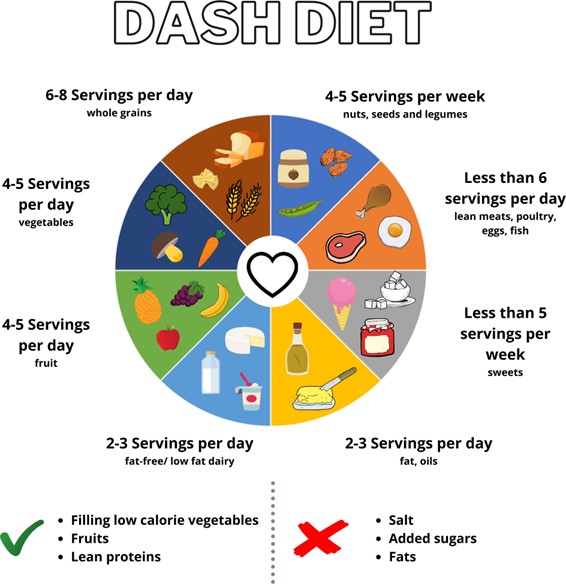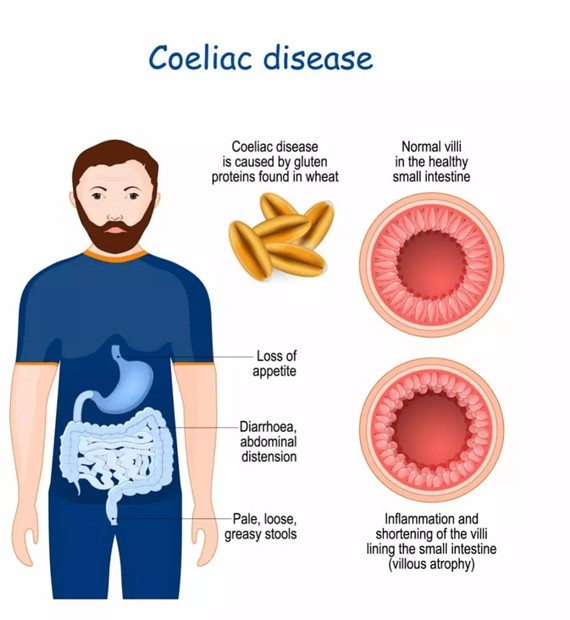A nurse is providing teaching about the Dietary Approaches to Stop Hypertension (DASH) diet to a client who has hypertension. Which of the following instructions should the nurse include?
"Consume ten percent of total calories from saturated fat."
"Increase intake of refined carbohydrates."
"Limit sodium intake to 3,200 milligrams per day."
"Consume foods that are high in calcium."
The Correct Answer is D
The DASH diet is a dietary approach specifically designed to lower blood pressure. It emphasizes consuming foods that are rich in nutrients like potassium, calcium, and magnesium, while reducing the intake of saturated fat, cholesterol, and sodium. Calcium-rich foods are an important component of the DASH diet as they have been shown to have a beneficial effect on blood pressure. Good sources of dietary calcium include low-fat dairy products, fortified
plant-based milk, leafy green vegetables, and calcium-fortified foods.
"Consume ten percent of total calories from saturated fat": The DASH diet recommends reducing the intake of saturated fat to improve heart health. The goal is to consume no more than 6% of total calories from saturated fat. Saturated fats are typically found in animal products, such as fatty cuts of meat, full-fat dairy products, and tropical oils like coconut and palm oil.
"Increase intake of refined carbohydrates": The DASH diet encourages the consumption of whole grains rather than refined carbohydrates. Whole grains are rich in fiber and other nutrients, which can help lower blood pressure. Refined carbohydrates, on the other hand, can lead to spikes in blood sugar levels and are generally less nutritious.
"Limit sodium intake to 3,200 milligrams per day": The DASH diet recommends reducing sodium intake to 2,300 milligrams per day or less. For individuals with hypertension or at risk for hypertension, including many clients with hypertension, further lowering sodium intake to 1,500 milligrams per day may be advised. Reducing sodium intake is important for blood pressure management.

Nursing Test Bank
Naxlex Comprehensive Predictor Exams
Related Questions
Correct Answer is B
Explanation
Coronary heart disease (CHD) is a condition characterized by the buildup of plaque in the coronary arteries, leading to reduced blood flow to the heart. Several risk factors contribute to the development of CHD, including high blood glucose levels, high levels of low-density lipoprotein (LDL) cholesterol, and high total cholesterol levels.
HbA1c 5%: HbA1c is a measure of average blood glucose levels over the past 2-3 months. A level of 5% is within the target range for individuals without diabetes and indicates good glycemic control. It does not place the client at risk for CHD.
Fasting glucose 140 mg/dL: Fasting glucose levels above 126 mg/dL are considered diagnostic criteria for diabetes mellitus. A level of 140 mg/dL indicates hyperglycemia and suggests impaired glucose metabolism, which is a risk factor for CHD.
LDL 64 mg/dL: LDL cholesterol is often referred to as "bad" cholesterol, as elevated levels are associated with an increased risk of CHD. A level of 64 mg/dL is within the desirable range and does not place the client at risk for CHD.
Total cholesterol 173 mg/dL: Total cholesterol levels below 200 mg/dL are generally considered desirable. A level of 173 mg/dL is within the desirable range and does not place the client at risk for CHD.
Correct Answer is A
Explanation
Celiac disease is an autoimmune disorder in which the ingestion of gluten, a protein found in wheat, rye, and barley, triggers an immune response and causes damage to the small intestine. Therefore, individuals with celiac disease need to follow a strict gluten-free diet.
Rice cereal with sliced bananas: This is a suitable choice as long as the rice cereal is gluten-free and there is no cross-contamination with gluten-containing ingredients. Rice is
naturally gluten-free, and fresh fruits like bananas are safe for individuals with celiac disease.
Rye toast with herbal tea: Rye is a gluten-containing grain, so rye toast is not suitable for someone with celiac disease. Herbal tea is typically gluten-free, but the toast is not appropriate.

Graham crackers with peanut butter: Graham crackers are usually made with wheat flour, which contains gluten. Therefore, they are not suitable for someone with celiac disease.
Poached eggs with wheat bagel: Wheat is a gluten-containing grain, so a wheat bagel is not appropriate for someone with celiac disease.
It is essential for individuals with celiac disease to carefully read food labels and select gluten-free options.
Whether you are a student looking to ace your exams or a practicing nurse seeking to enhance your expertise , our nursing education contents will empower you with the confidence and competence to make a difference in the lives of patients and become a respected leader in the healthcare field.
Visit Naxlex, invest in your future and unlock endless possibilities with our unparalleled nursing education contents today
Report Wrong Answer on the Current Question
Do you disagree with the answer? If yes, what is your expected answer? Explain.
Kindly be descriptive with the issue you are facing.
